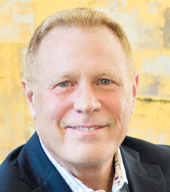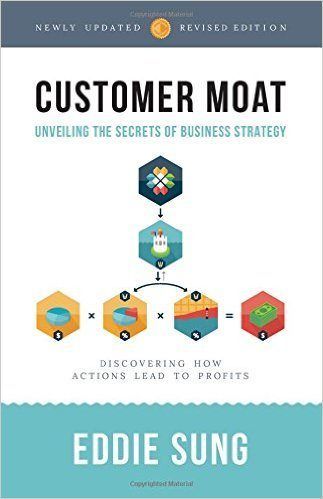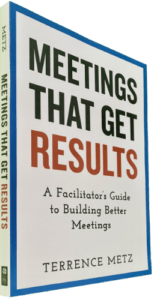Eddie Sung (Author) has released an easily readable book, Customer Moat: Unveiling the Secrets of Business Strategy, that some might call a primer.
Although his discussion does not break new ground (like “Blue Ocean Strategy“), he brings life and enjoyable reading to the basics of profit-building, illustrating the complex interrelationship of customer voice mixed with market factors that lead to profit. Thus, his story builds the analogy of a “moat” serving to isolate customers from competitive choices and alternatives.
His experience derives from a family-owned retail business and his rhetoric is biased by simple decision-making. Readers from more complicated commercial, industrial, and institutional environments may lack an easy conversion to their complex reality of multiple purchasing voices and influences within one customer organization. However, Eddie provides an excellent series of end notes and bibliography to both support his claims, thus making it easy for you to dive deeper based on your own, discrete scenario, and customer moat perspective. Therefore, his primary thesis builds upon eight “customer moat builders” including (alpha sort):
- Branding
- Cost
- Distribution
- Location
- Networking
- Scale
- Supply
- Value
(Part One)
The early premise provides a clear compendium of his MBA background and research. His explanation that customer moats impact market share, profit margin, and price is basic, although nicely illustrated. This section provides more value in growing and retaining a customer base than it does in providing insight into acquiring new customers and markets. He stresses “. . . how businesses hold on to their customers.” through operations, scale, positioning, and control. He concedes later “ . . . it is better to foster repeat customers. . . keeping existing ones is often more cost-effective.” and “The main purpose of the Brand moat builder is not to get new customers per se but to keep existing customers returning.”
(Part Two)
His detailed discussion about the eight customer moat builders remains vibrant and research-supported. While some of his examples are classic business tales (e.g., Ohno’s Five-Whys at Toyota), his writing style keeps the reader engaged as the pages turn quickly. However, he again primarily illustrates his claims with simple retail examples including 7-Eleven, Amazon, Costco, Krispy Kreme, McDonald’s, Southwest Airlines, Starbucks, Toyota (automobiles), Walgreens, and Wal-Mart among others.
His discussion on Network Effect (Scale) provides some of the freshest material and does not pre-supposes that he has the answers, he does offer up some excellent questions:
- “How do we get customers to enhance the experiences of other customers?” and
- “What types of information do our customers possess that we can use to improve their future experience?”
In the end, you should buy this book. Although I’ve never met him, I’m convinced that Eddie is a “good guy” and he certainly researched well, worked hard, and wrote clearly to make this book on customer moats available. Treat it somewhat as an updated “In Search of Excellence” as the takeaways are clear and valid, even fun. Be forewarned however that clear actionable takeaways may be lacking for readers who are not directly in the retail sector.
______
Don’t ruin your career by hosting bad meetings. Sign up for a workshop or send this to someone who should. MGRUSH workshops focus on meeting design and practice. Each person practices tools, methods, and activities daily during the week. Therefore, while some call this immersion, we call it the road to building high-value facilitation skills.
Our workshops also provide a superb way to earn up to 40 SEUs from the Scrum Alliance, 40 CDUs from IIBA, 40 Continuous Learning Points (CLPs) based on Federal Acquisition Certification Continuous Professional Learning Requirements using Training and Education activities, 40 Professional Development Units (PDUs) from SAVE International, as well as 4.0 CEUs for other professions. (See workshop and Reference Manual descriptions for details.)
Want a free 10-minute break timer? Sign up for our once-monthly newsletter HERE and receive a free timer along with four other of our favorite facilitation tools.

Terrence Metz, president of MG RUSH Facilitation Training, was just 22-years-old and working as a Sales Engineer at Honeywell when he recognized a widespread problem—most meetings were ineffective and poorly led, wasting both time and company resources. However, he also observed meetings that worked. What set them apart? A well-prepared leader who structured the session to ensure participants contributed meaningfully and achieved clear outcomes.
Throughout his career, Metz, who earned an MBA from Kellogg (Northwestern University) experienced and also trained in various facilitation techniques. In 2004, he purchased MG RUSH where he shifted his focus toward improving established meeting designs and building a curriculum that would teach others how to lead, facilitate, and structure meetings that drive results. His expertise in training world-class facilitators led to the 2020 publication of Meetings That Get Results: A Guide to Building Better Meetings, a comprehensive resource on effectively building consensus.
Grounded in the principle that “nobody is smarter than everybody,” the book details the why, what, and how of building consensus when making decisions, planning, and solving problems. Along with a Participant’s Guide and supplemental workshops, it supports learning from foundational awareness to professional certification.
Metz’s first book, Change or Die: A Business Process Improvement Manual, tackled the challenges of process optimization. His upcoming book, Catalyst: Facilitating Innovation, focuses on meetings and workshops that don’t simply end when time runs out but conclude with actionable next steps and clear assignments—ensuring progress beyond discussions and ideas.




